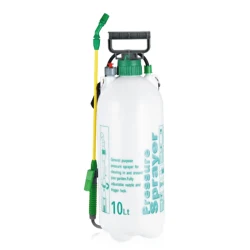Choosing the Right Garden Sprayer: A Comprehensive Guide
2024-08-24
Garden sprayers are essential tools for anyone who loves gardening. They help with everything from applying fertilizers and pesticides to watering plants and managing weeds. With various types of garden sprayers available, choosing the right one for your needs can make a significant difference in your gardening experience. Here’s a comprehensive guide to help you select the best garden sprayer for your garden.
1. Types of Garden Sprayers
Garden sprayers come in several types, each designed for specific tasks and applications. Understanding these types will help you choose the one that best fits your needs:
Handheld Sprayers: These are small, portable sprayers designed for light-duty tasks. They are ideal for applying fertilizers, insecticides, or herbicides to small garden areas or potted plants. Handheld sprayers are easy to use and typically come with adjustable nozzles for different spray patterns.
Pump Sprayers: Pump sprayers are versatile and suitable for medium to large gardens. They feature a pump mechanism that creates pressure to spray liquids. Pump sprayers are available in various capacities and often come with adjustable nozzles for customizable spray patterns. They are commonly used for applying pesticides, herbicides, and fertilizers.
Backpack Sprayers: Designed for larger gardens or extensive areas, backpack sprayers are worn on the back and feature adjustable straps for comfort. They have a larger capacity and a pressurized system that allows for extended use without frequent refilling. Backpack sprayers are ideal for applying chemicals, fertilizers, and water over larger areas.
Hose-End Sprayers: These sprayers attach directly to a garden hose and are convenient for large-scale applications. They mix the spray solution with water as it passes through the sprayer, allowing for even distribution over large areas. Hose-end sprayers are commonly used for applying fertilizers and pesticides to lawns and gardens.
Trigger Sprayers: Trigger sprayers are similar to handheld sprayers but are designed for smaller tasks. They have a trigger mechanism that allows for continuous spraying without the need for constant pumping. Trigger sprayers are perfect for spot treatments or smaller garden areas.
2. Key Features to Consider
When selecting a garden sprayer, consider the following features to ensure it meets your needs:
Capacity: Choose a sprayer with a capacity that matches the size of your garden or the amount of liquid you need to apply. Smaller sprayers are suitable for small areas, while larger sprayers are better for extensive gardens.
Nozzle Type and Adjustability: Look for a sprayer with adjustable nozzles that allow you to switch between different spray patterns, such as mist, stream, or fan. This feature provides flexibility for various applications and ensures even coverage.
Material and Durability: Select a sprayer made from durable, high-quality materials that can withstand the chemicals and liquids you plan to use. Look for sprayers with corrosion-resistant components to ensure longevity.
Comfort and Ergonomics: For sprayers that require carrying or prolonged use, consider comfort features such as padded straps, ergonomic handles, and adjustable settings. These features can reduce strain and make the sprayer more user-friendly.
Ease of Cleaning: Choose a sprayer that is easy to disassemble and clean. This feature is important for maintaining the sprayer’s performance and preventing clogs or residue buildup.
3. Tips for Using Garden Sprayers
To get the most out of your garden sprayer, follow these tips:
Read Instructions: Always read and follow the manufacturer’s instructions for both the sprayer and any chemicals or solutions you use. This ensures safe and effective use.
Use the Right Solution: Make sure you use the appropriate solution for your intended application. Mix chemicals and fertilizers according to the recommended ratios to avoid damaging plants.
Test the Sprayer: Before applying solutions to your entire garden, test the sprayer on a small area to ensure it works properly and provides the desired spray pattern.
Clean After Use: Thoroughly clean your sprayer after each use to remove any residue and prevent clogging. Rinse the sprayer with water and allow it to dry before storing it.
4. Applications of Garden Sprayers
Garden sprayers can be used for a variety of applications, including:
Pest Control: Apply insecticides or fungicides to control pests and diseases.
Fertilization: Use fertilizers to provide essential nutrients to your plants and improve growth.
Weed Management: Apply herbicides to manage and control weeds in your garden.
Watering: Use sprayers for efficient and targeted watering of plants, especially in hard-to-reach areas.
In conclusion, selecting the right garden sprayer can enhance your gardening experience and ensure effective application of various solutions. By understanding the different types and features of garden sprayers, you can choose the one that best suits your needs and helps you maintain a healthy and beautiful garden.



